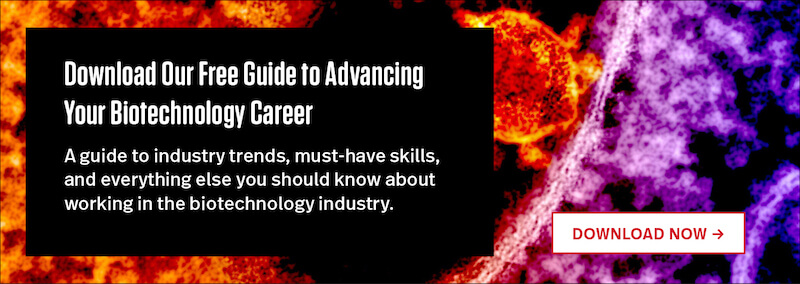Scientists and biotechnologists do incredible work every day in the fields of health, food production, and sustainability. However, the deeply technical nature of this work makes it difficult to explain its importance in a way that people without a technical background can understand.
Effective science communication puts complex concepts into simpler terms, helping researchers demonstrate the importance of their work to a wide range of stakeholders, from venture capitalists and business executives to the public and the press.
“The thing I try to instill with anyone is that you need to be able to present what you’re doing to your mom or dad so that they can understand it,” said Jared R. Auclair, PhD, Director of Executive Training and Biotechnology Programs in the department of chemistry and chemical biology at Northeastern University. “Take the time in your writing to state the obvious, because it’s not obvious to most people.”
Download Our Free Guide to Advancing Your Biotechnology Career
Learn how to transform your career in an industry that’s transforming the world.
These 10 tips will help you provide more effective science communication, whether you’re in the classroom or the boardroom, in a meeting with a few colleagues, or with dozens of members of the public.
10 Effective Communication Tips for Scientists
1. Know your audience.
The most important rule for effective science communication is to remember that different groups of people will have different expectations for speaking with you. Consider the following examples from the American Association for the Advancement of Science (AAAS) and the science communication consultancy Agent Majeur:
- The general public wants to know how your research impacts their lives and their societies. This communication could take the form of a formal presentation, or it could be a casual conversation with friends and neighbors.
- The media wants to know what makes the findings of your research important, including how it’s different from what others have done.
- Potential investors want to know whether your work will provide them with a significant return.
- Peers will be interested in determining whether your work may provide an opportunity for future collaboration.
- Leadership at your company needs to know if a project has achieved the expected results and should progress to the next phase, or if changes are needed.
It’s important to approach each audience differently and to tailor your communication based on the group’s unique interests.
2. Identify the goals of communication.
This step builds on the process of knowing your audience to determine the goals and objectives of communicating. In some cases, such as a meeting with internal business leaders or potential investors, the goal is often clear: To present your findings and gain support for additional work.
In other cases, such as public meetings or presentations, you may have one or more communication goals: to educate, to advocate, to raise awareness, to build trust, to influence policy or research, to encourage change, or to be part of a dialogue. In these scenarios, take some time in advance to research the group you’ll be addressing (as well as any other speakers) in order to better understand their point of view.
3. Start with the most important information.
In scientific or medical research, the key findings appear at the end of the paper, after the authors have provided background information, described their methodology, and identified potential limitations. The same is true for presentations at scientific conferences.
However, as the AAAS Communication Toolkit points out, the public, the media, and business stakeholders tend to absorb information in the opposite order. They want the key findings first, then the “So what?” that explains why the findings matter, and then the supporting details that led to your key findings. The research community may have the time and attention to devote to a lengthy paper or presentation, but co-workers and citizens alike have a lot to do. Keep this in mind as you plan your communication strategy.
4. Avoid jargon.
Acronyms, initialisms, abbreviations, and technical terminology are common in research papers, presentations, and on-the-job conversations. However, effective science communication stays away from jargon or unfamiliar words and uses terms that make sense to a broader audience. Writing in Forbes, former NASA meteorologist J. Marshall Shepherd, PhD, noted that, for the scientific community, “PDF” means “probability density function”—but for everyone else, it’s simply a document file format.
If scientific terminology must be used, explain it in more commonly understood terms. Test your explanation on a friend, family member, or colleague with a different professional and educational specialty to see if they know what you mean. Don’t be afraid to try multiple options before you find the terms that work best.
5. Be relatable.
One way to avoid scientific jargon is to incorporate analogies and stories into your scientific communication. For example, to help distinguish between weather and climate, Shepherd might say, “If you don’t like the weather, wait a few hours. If you don’t like the climate, move.”
In addition, Agent Majeur recommends storytelling as a way to “humanize” scientific research or other technical topics. A personal or professional anecdote will make a potentially complex topic seem more approachable, and it may leave an audience with something to remember. Just be sure that it ties back to your key findings or overall message.
Finally, conversations can enhance scientific communication. Instead of simply presenting information in a lecture format, it’s important to engage with an audience whenever possible—by taking questions after a presentation, responding to relevant comments on social media, and striving to address misconceptions instead of dismissing them. Conversations allow a dialogue to take place, which can help an audience get more comfortable with a scientific concept.
6. Provide visuals.
Charts, graphs, images, and other visuals are another way to avoid jargon and make an audience comfortable with a topic. “A picture speaks 1,000 words, and science is one industry where that holds true,” Auclair said. Visuals are also engaging for presentations in front of a large audience; the slides in TED Talks, for example, use pictures and graphs but very few words.
Creating data visualizations may seem daunting, but Auclair noted that Microsoft Excel has advanced capabilities for charts and graphs, and that many of the instruments that scientists use in the lab connect to software applications that create visuals for their specific data sets.
That said, Auclair cautioned against being too advanced: “One thing that I emphasize is not to hit us with a sledgehammer when a regular hammer will do. If you’re presenting to business people, you can be a little more technical than when you talk to your mom and dad, but you still need to be basic.”
7. Stick to three points.
From life, liberty, and the pursuit of happiness to stop, drop, and roll, many of the most memorable phrases in writing and storytelling stick to three key points. Effective science communication is no different.
The AAAS Communication Fundamentals note that these three points could come from several areas, such as the three major takeaways of your research, three uses for your product, or three important numbers that highlight a problem or solution. Your message shouldn’t just be about the three points—you should add the appropriate level of background information that’s relevant for your audience—but you should focus and emphasize those three points throughout your communication.
8. Talk about the scientific process.
One of the biggest challenges with science communication is that the scientific process is rarely final. A reader or audience member may ask a question with the hope of getting a “Yes” or “No,” but the actual answer is often conditional and requires further investigation. This disconnect can lead to frustration as well as mistrust.
Writing in Scientific American, former director of the communications organization Science in the News Katherine Wu suggests talking about the scientific process. Instead of focusing solely on the results, be ready to explain how you got there, why you used certain research methods, and what next steps you will take. In addition to serving an educational purpose, such as helping people distinguish between credible and suspect research, Wu said discussing the scientific process can spark curiosity in people without a scientific background.
9. Focus on the bigger impact.
Remember that the work you do in the lab or the field is part of a larger problem, whether it’s treating cancer or addressing climate change. Bringing your conversation back to the big-picture impact can help an audience understand why your work is important even if they may not understand the steps of your research or the nuances of biology or chemistry.
The American Society for Cell Biology notes that the impact could be financial, technological, educational, or political. It could also vary depending on the audience—financial for an internal presentation, educational for a visit to a local school, and so on. Keeping the big picture in mind will lead to more impactful and effective science communication.
10. Develop an elevator pitch.
You may associate the elevator pitch with startups looking for their next investor. However, the American Society for Cell Biology notes that a focused statement short enough to “pitch” while you ride an elevator with someone can help you quickly and effectively communicate the value of your scientific work.
The elevator pitch also offers an opportunity to practice many of the tips highlighted above:
- Focus on the big-picture relevance, not the nuances of your research question and methodology.
- Describe the goals of your research, using analogies wherever possible in order to avoid the use of jargon.
- Explain why your research is exciting. Highlight the problem you are trying to solve and tie it back to why your work is relevant.
Honing your Communication Skills
The Department of Biotechnology within the College of Science at Northeastern University trains students not just in the scientific rigors of a career in biotechnology but also in effective communication with business leaders and the public alike. To learn more about how an advanced degree program can help you improve your skills and further your scientific career, explore Northeastern’s MS in Biotechnology program, or download our eBook below.







Related Articles
Compliance Specialists: Who They Are and What They Earn
Science or Science Fiction? The Future of Personalized Medicine
In-Demand Biotechnology Careers Shaping Our Future